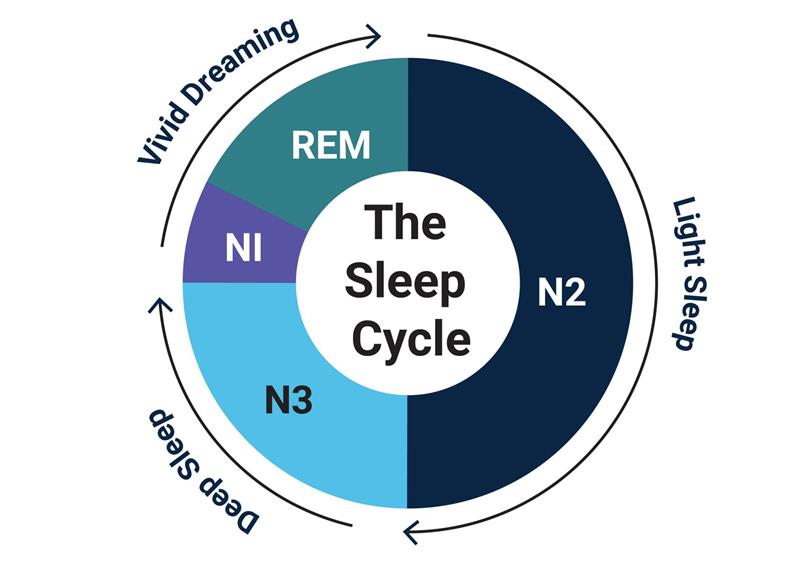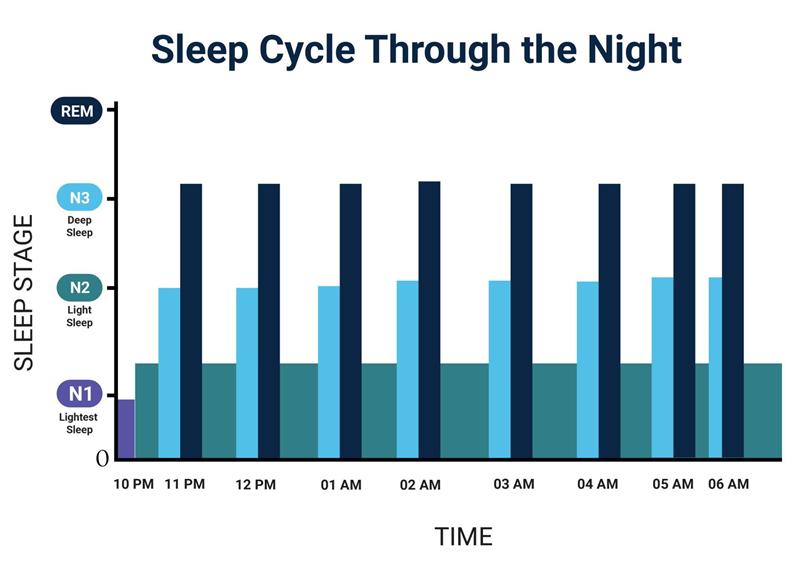Wowbeds Sleep Calculator – Find the Best Time to Sleep and Wake
Utilise our sleep calculator to plan your bedtime and wake-up time around natural sleep cycles. Wake feeling clear-headed instead of groggy.
Sleep Calculator
Calculate optimal sleep times based on your age and preferences.
Recommended Sleep Times
Your Results Will Appear Here
Fill out the form and click "Calculate Sleep Times" to see your personalized sleep recommendations.
Introduction
Your sleep quality depends less on the number of hours you have been sleeping and more importantly, on sleep cycles. The sleep cycle, on average, is 90 minutes long and will progress through three levels of sleep: light sleep, deep sleep, and REM (Rapid Eye Movement) sleep. If you wake up during deep sleep, you are likely to feel a sense of "heaviness" or sluggishness. If you wake up at the end of a sleep cycle, the waking process is going to feel much more natural in the morning.
The Wowbeds Sleep Calculator utilises sleep cycles to tell you when to go to sleep or wake up. All you need to do is enter one time - a desired wake-up or bedtime - and we will provide you with other corresponding times that accommodate completed sleep cycles.

How the Calculator Works
The idea behind our calculator is simple: adults need anywhere from seven to nine hours of sleep, which translates to five or six sleep cycles of about ninety minutes each night. On average, it takes about fifteen minutes to fall asleep.
By combining these numbers, the calculator works out the ideal windows for going to bed or waking up. For example, if you need to rise at 6:30 AM, the calculator might recommend falling asleep at 9:15 PM, 10:45 PM, or midnight. All of these options allow your body to complete full cycles and avoid mid-cycle wake-ups.

Why Sleep Cycles Matter
Your body and brain recover in stages overnight. During light sleep, muscles relax and body temperature drops. In deep sleep, tissue repairs, hormones are released, and energy is replenished. REM sleep assists with memory, learning, and mood regulation.
If your stages of sleep are interrupted, your brain may feel groggy, forgetful, and less alert. If you are planning to sleep around cycles, it will give your body the opportunity to naturally reset before getting out of bed during a light sleep stage.

Sleep Cycle Basics
Sleep is more than just some hours spent in bed. Each night, your body cycles through sleep stages (light sleep, deep sleep, and REM (rapid eye movement) sleep). Each sleep cycle lasts about 90 minutes, and waking at the end of a cycle will leave you feeling more refreshed than waking during a cycle. The sleep calculator is designed to time your sleep so that you wake at the end of a sleep cycle.
Not everyone knows how much sleep they actually need, and many of us are not great at monitoring our bedtime routines. The amount of sleep necessary varies by age and lifestyle, but sleep quality is an important factor for energy, concentration, and long-term health. Most adults need between 7 and 9 hours of sleep each night, while babies, children, and teenagers need more. Use our Wowbeds Sleep Calculator to figure out when to go to bed or wake up to allow your body to cycle naturally through the stages of sleep.

Sleep Calculator Results (example explanation)
When you use the Wowbeds Sleep Calculator, the results will show you several time options. These are designed to fit full cycles into your night. The calculator won’t be exact for everyone; sleep patterns vary by age, health, and lifestyle, but it’s a practical way to get closer to a routine that matches your body’s rhythm.
Tips for Using the Calculator
- Allow a short buffer for falling asleep. Most people need about 10–20 minutes.
- Stick to consistent sleep and wake times, even on weekends.
- Avoid caffeine, alcohol, and screens before bed, as they can push your cycles out of sync.
- Pair the calculator with a supportive mattress to avoid interruptions during cycles.
Wowbeds Connection
Sleep is a healthy habit that begins with time management, but is also made better with comfort. A mattress that minimises motion, maintains spinal alignment, and regulates your body temperature provides the best chance to drift through all sleep stages.
At Wowbeds, we have mattresses suited best for the Australian consumers, made from breathable foams and advanced coil systems. With both the Sleep Calculator and the right mattress, you are set for mornings that feel better.
Sources
- National Institute of Neurological Disorders and Stroke. (2023). Brain basics: Understanding sleep. https://www.ninds.nih.gov
- Carskadon, M. A., & Dement, W. C. (2017). Normal human sleep: An overview. In M. H. Kryger, T. Roth, & W. C. Dement (Eds.), Principles and practice of sleep medicine (6th ed.). Elsevier.
- Kecklund, G., & Axelsson, J. (2016). Health consequences of shift work and insufficient sleep. BMJ, 355, i5210. https://doi.org/10.1136/bmj.i5210
- Hirshkowitz, M., et al. (2015). National Sleep Foundation’s sleep time duration recommendations: Methodology and results summary. Sleep Health, 1(1), 40–43. https://doi.org/10.1016/j.jsmhc.2014.12.010
- Harvard Medical School, Division of Sleep Medicine. (2020). Blue light has a dark side. https://www.health.harvard.edu
- Mednick, S., & Ehrman, M. (2021). The restorative power of naps. Sleep Medicine Reviews, 58, 101444. https://doi.org/10.1016/j.smrv.2021.101444
Paruthi, S., et al. (2016). Recommended amount of sleep for pediatric populations: A consensus statement of the American Academy of Sleep Medicine. Journal of Clinical Sleep Medicine, 12(6), 785–786. https://doi.org/10.5664/jcsm.5866
FAQ's
Is the Wowbeds Sleep Calculator medically approved?
The Wowbeds Sleep Calculator is intended to serve as an accessible resource to assist you in planning your sleep with respect to natural cycles. It is based on scientific findings regarding sleep stages and average sleep cycle duration, but should not be considered a definitive medical solution. The human body is unique, and though adults usually sleep in cycles that last about 90 minutes, variations will occur based on individual factors such as age, stress, and other health problems. If you are experiencing ongoing sleep disorders, such as insomnia, excessive daytime sleepiness, or a disrupted sleep cycle, you should speak to a healthcare professional. The calculator is best used as a strategy for day-to-day sleep planning, not as a clinical solution.
How long is a typical sleep cycle?
On average, a sleep cycle lasts about 90 minutes, though cycles can last anywhere from 80 to 110 minutes depending on the individual. Each cycle consists of a series of stages: light sleep, deep sleep, and REM sleep. The first cycle is typically shorter in REM sleep and longer in deep sleep, but as the night progresses, you will spend more time in REM, as your body is focused on mental restoration. Aiming to wake at the end of a cycle rather than in the middle of a cycle can lessen the feeling of grogginess and morning fatigue.
Can I use this if I’m a shift worker?
Yes, the Wowbeds Sleep Calculator can be worthwhile for those who work shifts. The body's internal clock naturally has a day–night rhythm; however, when you are working odd hours, you can still prioritise your sleep to maximise full cycles. The calculator will tell you a time to sleep and a time to wake, no matter what hour you climb into bed. The best way to make the most out of it is to keep your room dark (benefiting from blackout curtains if possible), avoid caffeine, and develop a short pre-sleep routine to help your body understand it is time to settle for rest. There is no magic tool to dismantle the inherent challenges of shift work; however, orienting your sleep around the idea of full cycles will certainly mitigate some fatigue and improve alertness.
How many cycles should I aim for?
For the vast majority of adults, five to six sleep cycles per night is ideal, which is a total of about seven to nine hours of sleep. Four cycles (which is around six hours) might be adequate for some individuals occasionally, but habitual practice of sleeping less would significantly leave you under-rested. Younger adults and teenagers typically need more cycles, while older adults naturally tend to sleep in shorter stretches. The calculator gives you several bedtime and wake-up options so you can match your lifestyle without cutting your rest short. Think of cycles as building blocks: the more complete ones you fit in, the better your body and mind can recover.
What if I don’t fall asleep right away?
The calculator assumes it typically will take 10-20 minutes for most people to fall asleep. If you find you are tossing and turning for longer than that, consider establishing a routine before bed. This may consist of dimming lights, reading a book, or listening to soothing music. Limiting screen time before bed is also beneficial, as blue light from phones and tablets suppresses the release of melatonin (the sleep hormone). If you take longer than normal to fall asleep, consider adjusting your planned bedtime earlier by a few minutes so you can still fall asleep relatively close to your planned wake-up time.
Do naps count toward sleep cycles?
Naps can be beneficial for improving alertness and mood, but naps are not always a complete cycle. Twenty minutes will refresh you without any grogginess, and 90 minutes will allow your body to complete a sleep cycle. Anything in between may cause you to wake up in a deep stage of sleep, which can feel disoriented. If you consider the total hours at night with the calculator, reflect on naps as a supplement and not as a substitute for complete nightly cycles.
Is the calculator suitable for children or older adults?
The calculator is established for adults since children's and teens' sleep requirements differ significantly. Young children may get up to 12 hours, and teens usually require 8-10 hours. Older adults typically experience shorter and more disrupted sleep, but the sleep cycle is still important at all ages. So, if you are figuring sleep for a family member, use the same 90-minute sleep cycle; adjust total hours from scientific research recommendations based on age.
Sources
- National Institute of Neurological Disorders and Stroke. (2023). Brain basics: Understanding sleep. https://www.ninds.nih.gov
- Carskadon, M. A., & Dement, W. C. (2017). Normal human sleep: An overview. In M. H. Kryger, T. Roth, & W. C. Dement (Eds.), Principles and practice of sleep medicine (6th ed.). Elsevier.
- Kecklund, G., & Axelsson, J. (2016). Health consequences of shift work and insufficient sleep. BMJ, 355, i5210. https://doi.org/10.1136/bmj.i5210
- Hirshkowitz, M., et al. (2015). National Sleep Foundation’s sleep time duration recommendations: Methodology and results summary. Sleep Health, 1(1), 40–43. https://doi.org/10.1016/j.jsmhc.2014.12.010
- Harvard Medical School, Division of Sleep Medicine. (2020). Blue light has a dark side. https://www.health.harvard.edu
- Mednick, S., & Ehrman, M. (2021). The restorative power of naps. Sleep Medicine Reviews, 58, 101444. https://doi.org/10.1016/j.smrv.2021.101444
Paruthi, S., et al. (2016). Recommended amount of sleep for pediatric populations: A consensus statement of the American Academy of Sleep Medicine. Journal of Clinical Sleep Medicine, 12(6), 785–786. https://doi.org/10.5664/jcsm.5866
Ready to Improve Your Sleep?
Use the Wowbeds Sleep Calculator tonight and start matching your rest to your body’s rhythm. Pair it with a mattress that supports your natural cycles, and you’ll notice the change in how you feel every morning.
